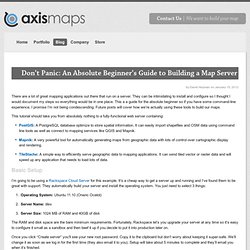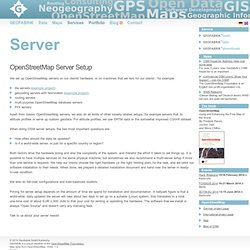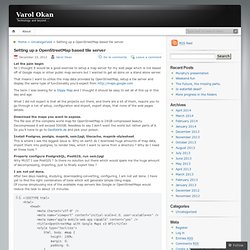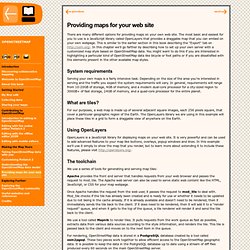

Don’t Panic: An Absolute Beginner’s Guide to Building a Map Server - Axis Maps Blog. There are a lot of great mapping applications out there that run on a server.

They can be intimidating to install and configure so I thought I would document my steps so everything would be in one place. This a a guide for the absolute beginner so if you have some command-line experience, I promise I’m not being condescending. Future posts will cover how we’re actually using these tools to build our maps. This tutorial should take you from absolutely nothing to a fully-functional web server containing: PostGIS: A PostgreSQL database optimize to store spatial information. Basic Setup I’m going to be using a Rackspace Cloud Server for this example. Operating System: Ubuntu 11.10 (Oneric Ocelot)Server Name: tilesServer Size: 1024 MB of RAM and 40GB of disk The RAM and disk space are the bare minimum requirements. Once you click “Create server” you’ll see your new root password. Terminal and Remote Access ssh root@(your ip-address) root@tiles:~# passwd and hit enter and follow the prompts. tiles.
Manually building a tile server. This page describes how to install, setup and configure all the necessary software to operate your own tile server.

The step-by-step instructions are written for Ubuntu Linux 12.04 LTS (Precise Pangolin), however they should transfer fairly straightforwardly to other versions of Ubuntu or Linux distributions. This howto is based on an earlier version for Ubuntu Linux 10.04 The OSM tile server stack is a collection of programs and libraries that work together to create a tile server.
As so often with OpenStreetMap, there are many ways to achieve this goal and nearly all of the components have alternatives that have various specific advantages and disadvantages. This tutorial describes the most standard version that is also used on the main OpenStreetMap.org tile server. It consists of 5 main components: Mod_tile, renderd, mapnik, osm2pgsql and a postgresql/postgis database. In order to build these components, a variety of dependencies need to be installed first. Installing osm2pgsql replace. Geofabrik Server. We set up OpenStreetMap servers on our clients' hardware, or on machines that we rent for our clients - for example tile servers (example project)geocoding servers with Nominatim (example project)routing serversmulti-purpose OpenStreetMap database serversPOI servers Apart from classic OpenStreetMap servers, we also do all kinds of other loosely related setups, for example servers that do altitude profiles or serve up custom geodata.

For altitude profiles, we use SRTM data or the somewhat improved CGIAR dataset. When doing OSM server setups, the two most important questions are: How often should the data be updated? Both factors drive the hardware sizing and also the complexity of the system, and therefor the effort it takes to set things up. We also do fail-over configurations and load-balanced clusters. Pricing for server setup depends on the amount of time we spend for installation and documentation. Setting up a OpenStreetMap based tile server. Let the pain begin So I thought it would be a good exercise to setup a map server for my web page which is not based off of Google maps or other public map servers but I wanted to get all done on a stand alone server.

That means I want to utilize the map data provided by OpenStreetMap, setup a tile server and display the same type of functionality you’d expect from The term I was looking for is Slippy Map and I thought it should be easy to set all of this up in this day and age. What I did not expect is that all the projects out there, and there are a lot of them, require you to go through a ton of setup, configuration and import, export steps, that none of the web pages details. Download the maps you want to expose. The file size of the complete world map for OpenStreetMap is 24GB compressed beauty. Install Postgres, postgis, mapnik, osm2pgl, tilecache, mapnik-stylesheet This is where I see the biggest issue is.
Properly configure PostgreSQL, PostGIS, run osm2pgl Why MUST I use PostGIS ? OpenStreetMap. There are many different options for providing maps on your own web site.

The most basic and easiest for you to use is a JavaScript library called OpenLayers that provides a draggable map that you can embed on your own webpage. This is similar to the earlier section in this book describing the "Export" tab on In this chapter we'll go farther by describing how to set up your own server with a customized map style based on OpenStreetMap data. You might want to do this if you are interested in highlighting a particular kind of OpenStreetMap data like bicycle or foot paths or if you are dissatisfied with the elements present in the other available map styles.
System requirements Serving your own maps is a fairly intensive task. What are tiles? For our purposes, a web map is made up of several adjacent square images, each 256 pixels square, that cover a particular geographic region of the Earth. Using OpenLayers.